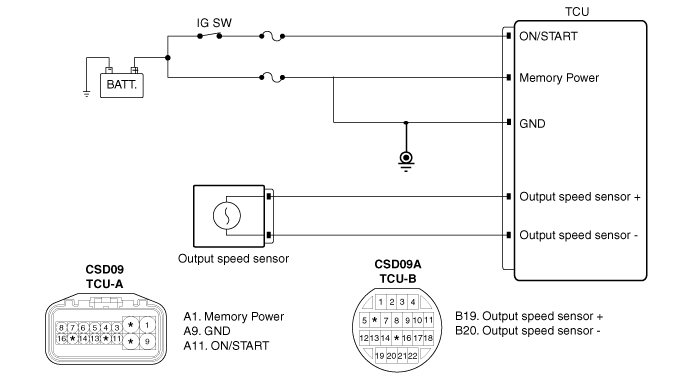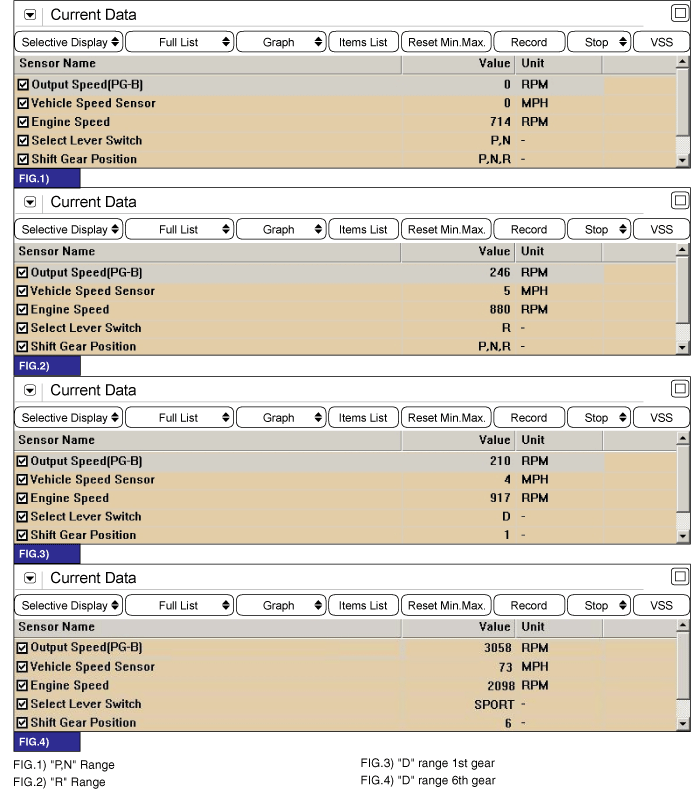
The Output Speed Sensor
outputs pulse-signals according to the revolutions of the output shaft of
the transmission. The Output Speed Sensor is installed inside
transmission. This value, together with the throttle position data, is
mainly used to decide the optimum gear position.
The TCM sets this code
if the calculated value of the pulse-signal is noticeably different from
the value calculated, using the Vehicle Speed Sensor output. The TCM will
initiate the fail safe function if this code is detected.
Item
|
Detecting
Condition
|
Possible cause
|
DTC Strategy
|
|
| •
|
Faulty OUTPUT SPEED
SENSOR. |
| •
|
Signal circuit is open or
short | |
Enable Conditions
|
| •
|
10.2V <Battery voltage
<15.5V |
| •
|
TCU communication =
normal |
| •
|
Shift lever switch =
normal | |
Threshold value
|
| •
|
To detect no pulse while detecting input
revolution sensor signal 16
pulses | |
Diagnostic Time
|
| •
|
More than 500 times × more
than1sec | |
Fail Safe
|
| •
|
Self learning control is
inhibited |
|

| 1. |
Connect scan tool to data link
connector(DLC). |
| 3. |
Monitor the "OUTPUT SPEED SENSOR" parameter on
the scantool. |
| 4. |
Driving at speed of over 19 Mile/h(30
Km/h).
Specification
: Increasing
Gradually
|

|
| 5. |
Does "output speed sensor" follow the
reference data?
|

|
▶ Fault is
intermittent caused by poor contact in the sensor's and/or
TCM(PCM)'s connector or was repaired and TCM(PCM) memory was
not cleared. Thoroughly check connectors for looseness, poor
connection, bending, corrosion, contamination, deterioration
or damage. Repair or replace as necessary and go to
"Verification of Vehicle Repair" procedure.
|
|

|
▶ Go to
"Terminal and connector inspection"
procedure.
|
|
| Terminal And Connector
Inspection |
| 1. |
Many malfunctions in the electrical system may
be caused from poor harness and terminal condition. These faults can
be caused by interference from other electrical systems and
mechanical or chemical damage. |
| 2. |
Thoroughly check connectors for looseness,
poor connection, bending, corrosion, contamination, deterioration,
or damage. |
| 3. |
Has a problem been found?
|

|
▶ Repair as
necessary and go to "Verification of vehicle repair"
procedure.
|
|

|
▶ Go to
"Signal circuit inspection"
procedure.
|
|
| Signal Circuit
Inspection |
| 1. |
Engine "OFF" IG KEY
"OFF". |
| 3. |
Perform the continuity test between "OUTPUT
SPEED SENSOR" sensor terminal and chassis ground.
Specification
: Not continuity
| |
| 4. |
Is resistance within
specifications?
|

|
▶
Substitute with a known-good PCM/TCM and check for proper
operation. If the problem is corrected, replace PCM/TCM as
necessary and then go to "Verification of Vehicle Repair"
procedure.
|
|

|
▶ Replace
"TRANSAXLE FLUID TEMPERATURE SENSOR" as necessary and Go to
"Verification of Vehicle Repair"
procedure.
|
|
NOTE)
When replacing the TCU,
must perform the N position learning and the Initial learning. (refer to
Troubleshooting's 'How to perform N position learning' and 'How to perform
initial learning')
| Verification of Vehicle
Repair |
After a repair, it is
essential to verify that the fault has been corrected.
| 1. |
Connect scan tool and select "Diagnostic
Trouble Codes(DTCs)" mode |
| 2. |
Using a scantool, Clear
DTC. |
| 3. |
Operate the vehicle within DTC Enable
conditions in General information. |
| 4. |
Are you DTCs present?
|

|
▶ Go to the
applicable troubleshooting procedure.
|
|

|
▶ System
performing to specification at this
time.
|
|